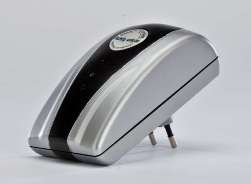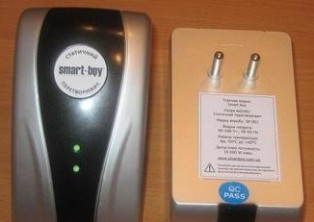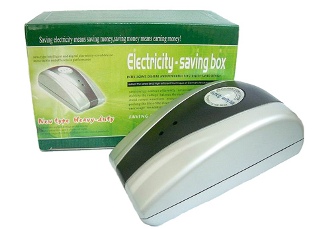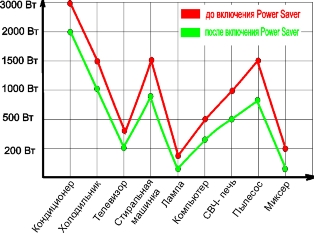Categories: Controversial issues, Interesting electrical news, How does it work, Energy saving
Number of views: 859302
Comments on the article: 212
Energy saving appliances: myth or reality?
 Not so long ago, in our markets, on the Internet, in some print media and even on television, an advertisement for a miracle device appeared, which, according to advertisers, can save up to 30-35% of electricity. What kind of device is this? How is it arranged? And is it really true that he is able to save so much energy?
Not so long ago, in our markets, on the Internet, in some print media and even on television, an advertisement for a miracle device appeared, which, according to advertisers, can save up to 30-35% of electricity. What kind of device is this? How is it arranged? And is it really true that he is able to save so much energy?
At about the same time, in different regions, these devices appeared under different names. Here are the approximate names of these same devices: SberBox, smartbox, Energy Saver, Pover Saver, Saving-box, Powersave, Economy etc.
According to manufacturers, and accordingly distributors, it is enough to simply plug the device into a power outlet, and it starts to work, that is, save our hard-earned money.
The cost of this device, depending on the region of distribution and the "generosity" of sellers, ranged from $ 10 to $ 70. In the simplest version, the device is designed for 15 kW of load for a single-phase network, that is, for an average house. There are also devices for three phase networks. For example, such a device for saving energy, designed to operate in a three-phase network, for a load of up to 48 kW, has the dimensions of an ordinary pack of washing powder.
The first acquaintance with the description of this device for saving energy causes delight among electrical engineers, mixed with a sense of their own incompetence. The device has a solid list of features realized with the help of mysterious, patented technical innovations.
It is difficult for specialists to imagine how it is possible to implement such functions as reactive power compensation, interference filtering, protection from phase imbalance and lightning strikes in one device. The revolutionary possibility of converting reactive electric energy into active energy has no analogues at all. Such a prospect immediately brings the power engineers of industrial enterprises into a state of ecstasy.
Let's take a closer look at the wonderful product and think about whether it is possible to realize all the declared characteristics in one device. And aren't they asking too little for him? Indeed, automatic capacitor units of comparable power are 4-6 times more expensive.
Stabilizers for balancing voltage imbalance in phases are also not cheap. Harmonic filters, bulky products containing a large amount of iron and copper, also do not suffer from a low price. Combining the capabilities of all these devices in one product is truly an impressive achievement.

Energy-saving Smart Boy
In advertising articles, magnificent photos of the appearance of the device, connection diagrams are given. But images of devices with an open case are almost impossible to find. And you can understand why: instead of the declared 5 blocks and modules, such as a programmable controller and a control (?) Transformer, there is a simple, poor set of parts.
So, we purchased one of these devices, in order to try to deal with it. What is he like? This is a small box that resembles an ordinary charger, on the front panel there are two LEDs.
Taking the liberty, we tried to look inside this miraculous device. What did we see inside? Inside was a diode bridge, a capacitor of indefinite capacity and a small power supply from which the LEDs were powered. And ... actually all. The most expensive part is a stylish case with a network plug. The total cost of components is unlikely to exceed $ 3-4, and the cheapest model is already sold for 40. What kind of energy savings can we talk about with such a scheme?
how Smart boy saves energy
So still, due to what happens energy saving when using this type of energy-saving appliances? And here it is necessary to plunge a little into the theory, without it anywhere. Let's try to explain everything in a simple, understandable language.
So, energy is active and reactive. We will not dwell on the higher harmonics, interferences in the power supply, phase shifts and other tricks, we will only consider what you can really encounter in real life, in everyday life, so to speak.
Ordinary household consumers of electricity, that is, you and I, pay for the consumption of active energy. Large enterprises also pay for jet energy. For this, they have special counters installed that count this very reagent.
In fact, they, enterprises, do not consume, they produce it. That is, equipment with a large inductive component generates reactive energy, which additionally loads the network. In order to "unload" electrical networks from negative loads, there are special devices - Reactive Power Compensators, that is, CRM.
These very KPMs, rather bulky and complex devices, moreover, they are initially calculated for a certain load. And this miracle device, which is actually being discussed now, if it can save something, theoretically, then only with a strictly defined load. And to calculate this very load is almost impossible.
Many modern devices are already initially equipped with devices to compensate for the reactive component. So, for example, almost all computer power supplies are equipped with Passive PFC, which reduces energy consumption by 5-10%. But in this case, the ratings of the capacitance, inductor and other iron were very carefully calculated, which allowed us to reduce electricity consumption.
From all that has been written above, we can conclude that it is pointless to compensate for anything at home or in everyday conditions.
But, for the sake of fairness, our experiments in production showed that, with the use of three-phase static CRM, it yielded some results. Namely, it allowed to stabilize the phase imbalance by 10-15%, that is, to evenly distribute the load between the phases. But this is in production, where the loads were relatively constant. So, draw your own conclusions.

How a miracle device converts reactive energy into active
We will separately discuss the conversion of reactive energy into active. Now only the energy-saving Smart Boy device declares a similar opportunity. In electrical engineering, there is neither theoretical justification for such an opportunity, nor practical implementations of devices. All attempts to obtain more detailed technical information from dealers about this amazing opportunity were unsuccessful. They either quoted advertising presentations, or referred to the "know-how" of the developers.
The triumph of modern technology or a grandiose scam?
What alarms specialists is completely incomprehensible to the rest of the population, far from electrical engineering. Well, how can you resist when a gray-haired doctor of technical sciences (and a doctor?) On the TV screen penetrates the profitability of acquiring a device at a discount for pensioners? Judging by the scope and duration of the commercials, sales are doing well.

From advertising device to save energy Pover Saver
In conclusion, we can say that, unfortunately, a huge number of people, including those familiar with electrical engineering, were victims of a giant scam called “Smart Boy Energy Saving” and similar devices to save energy. These devices do not have any unique or revolutionary properties; they are absolutely useless in production and, especially, in everyday life.
References to the fact that the products are certified in the CIS countries (it is understood that consumer properties are confirmed by serious organizations) is just a guile, designed to ignore the certification procedures. The check is carried out only on the basis of product safety indicators; consumer properties are not considered at all. In other words: if you have purchased bitter, like wormwood, chocolate, then it can be absolutely safe for you, but for the taste - sorry.
See also:
Is reactive electricity available?
Options for reactive energy compensation in the home using the Saving Box
New appliance and new principle of energy saving
See also at e.imadeself.com
:
